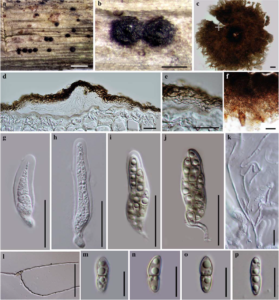Tothia spartii Qing Tian, Camporesi&K.D.Hyde.
Index Fungorum number: IF550898, Facesoffungi number: FoF00401; Fig. 1
Etymology – The specific epithet spartii refers to the host genus on which the fungus occurs.
Holotypus – MFLU 14–0739
Saprobic on a dead or living branches of Spartium junceum. Sexual morph Superficial mycelium absent. Ascomata (170–) 185 – 250 (–270) × (150–) 180 – (280–) 300 μm (x̄ = 232 × 210.5 μm, n = 10), superficial on branches, solitary, scattered, sometimes gregarious, thyriothecial , dome-shaped or flat-conical, black, membranaceous, opening by a short, papillateostiole . Peridium thick at the apex, 18 (–25) – (20–) 23 μm (x̄ = 21.5 μm, n = 5), upper wall comprising irregular-lobed cells, tightly fitting together like a jigsaw puzzle, one-layered, lower wall poorly developed. Hamathecium comprising 1 – 3 μm broad long, hyaline, pseudoparaphyses, with transverse septa, branched, longer than asci. Asci 30 (–35) – 50 (–55) × 7 (–9) – 12 (–13) μm (x̄ = 42 × 10.5 μm, n = 10), 8 – spored, bitunicate, fissitunicate, obclavate, with a knob-like short-pedicellate, thin-walled. Ascospores (10–) 11 – 12 (–13) × (3–) 4 – 4 (–5) μm (x̄ = 10.5 × 4.2 μm, n = 10), biseriate or multi-seriate, ellipsoid to fusiform, 1-septate, normally unequal, upper cell slightly wider than the lower, slightly constricted at the septum, rounded at both sides, hyaline and becoming light brown when mature, with four guttules, smooth-walled. Asexual morph Undetermined.
Culture characters – Colonies on PDA erumpent, slow growing, reaching 1 cm diam. after 20 d, velvety, mycelium black, dense, globose to irregular, in the centre raised, with water droplets on the surface, reverse dark, sunken. No asexual morph was produced on PDA after 60 d incubation.
Material examined – ITALY, Province of Forlì-Cesena [FC], Fiumicello, Premilcuore, on living and dead branches of Spartium junceum (Fabaceae), 17 March 2012, E. Camporesi (MFLU 14–0739, holotype); ex-type living culture, MFLUCC 14–0615. GenBank ITS: KR025861; LSU: KR025865.
Notes – Tothia is a monotypic genus which was introduced to accommodate type species Tothia fuscella (Sacc.) Bat. It is a poorly known genus forming thyriothecia and classified in the Microthyriaceae by Lumbsch and Huhndorf (2010). Tothia shares morphological characters with typical representatives of Microthyriaceae, such as two-celled, guttulate, and slightly asymmetrical ascospores which resemble Microthyrium, but differ in being brown. Thyriothecial ascomata are unusual for the Venturiaceae, however, most genera in Venturiaceae usually have yellowish, greenish brown to brown, two-celled ascospores and obclavate asci which match Tothia well (Barr 1968, 1989). In recent studies, Tothia was found to be most closely related to the Venturiaceae based on analysis of LSU and ITS rRNA genes (Hyde et al. 2013; Wu et al. 2011). In addition, our study confirmed the placement of Tothia in Venturiaceae and indicated the new collection to be a new species based on analysis of LSU, SSU, TEF1 and RPB2 genes. Ascospores of T. fuscella are fusiform or oblong-ellipsoid, tapering at both sides, while ascospores are ellipsoid to fusiform and rounded at both sides in T. sparticola

Fig. 1 Tothia spartii (holotype) a, b Ascomata on the host c, f Squash mount of ascoma d, e Vertical section of ascoma g – j Asci with ascospores k Pseudoparaphyses l Germinating ascospore m – p Ascospores. Scale bars: a = 1000 μm, b = 200 μm, c – k = 20 μm, l = 50 μm, m – p = 10 μm.
